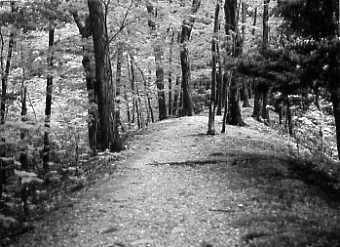[By Allen Brougham] . . .
Its very name conjures visions of a trail I simply had to go biking on. And a website offered by Pennsylvania's Rails to Trails program described it as having a dirt and original ballast surface, open for public use. I was joined by my biking buddy Gilbert Elmond a few spring seasons ago as we set forth to explore the 10-mile Iron Horse Trail in the Tuscarora State Forest in Perry County, Pennsylvania.
It took us the better part of three hours to reach the place, getting lost for several minutes as we tried to decipher our map showing the back roads to this tucked-away spot. In due time we found the headquarters for the forest preserve. As we entered the building, I overheard one of the employees say: "I see they have bikes; I guess we ought to tell them some things about our trails!"
"Primitive" is the best description of the Iron Horse Trail. While a mountain bike could negotiate portions of it, we decided that "hiking" would make better use of our time. And since we had come such a long distance to get there, we did not want to leave the scene without at least doing something to pay it justice.
First we hiked the one-mile "Tunnel Loop." The feature attraction on this segment was the mouth of a tunnel, fenced off to discourage entry, and a sign not to go beyond that point. Indeed, the tunnel appeared to have seen better days.
Next we paid a visit to the Iron Horse Trail itself, but only for a short portion. Had it not been described as having once been a railroad bed, we may as well have thought it was no more than a typical forest trail.

Far from being a trail that was once a mainline railroad, the Iron Horse Trail followed what had been a narrow gauge logging line. In fact, it actually follows two logging lines - the Path Valley and Perry Lumber railroads. Both had been abandoned almost a century ago. This description, however, does not recognize what might have been had earlier plans materialized.
According to information happily supplied by the folks at the forest headquarters, the Path Valley Railroad was envisioned in 1893 as an extension of the Newport & Shermans Valley Railroad beginning from the village of New Germantown, Pennsylvania, through the mountains to Franklin County, and eventually to Hancock, Maryland. One may wonder how this plan might have changed the railroad scene today had it succeeded. But the venture went bust with only the tunnel to support the project's only major effort toward fruition.
Then, in 1901, the Perry Lumber Company purchased a "Climax" locomotive and began using it to remove timber in western Perry County over a portion of the aborted Path Valley line to Big Spring Park with a branch into Bowman Hollow, Rising Mountain and Fowlers Hollow, and a spur into Second Narrows Gap. If these names are not household words, it should be remembered that this was a logging line, not a mainline high iron. The Perry Lumber Company disbanded in 1906, and its trackage and lands were sold to the state of Pennsylvania, one of the first major acquisitions toward what is now the Tuscarora State Forest.